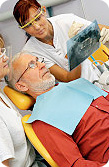Mouth Strategies Ease Dementia Patients’ Anxieties
Mouth Strategies Ease Dementia Patients’ Anxieties Providing oral hygiene to dementia patients can be a tricky proposition at best, and can be especially difficult for clinicians whose dementia patients respond to oral care by attempting to bite or fight the
MOUTh Strategies Ease Dementia Patients’ Anxieties
 Providing oral hygiene to dementia patients can be a tricky proposition at best, and can be especially difficult for clinicians whose dementia patients respond to oral care by attempting to bite or fight the clinician. A group of nurses at Penn State, however, have launched a pilot study to explore methods for improving oral care to persons who have dementia.
Providing oral hygiene to dementia patients can be a tricky proposition at best, and can be especially difficult for clinicians whose dementia patients respond to oral care by attempting to bite or fight the clinician. A group of nurses at Penn State, however, have launched a pilot study to explore methods for improving oral care to persons who have dementia.
“To my knowledge, we are the only nurses in the country who are looking at ways to improve the oral care of persons with dementia,” notes Rita A. Jablonski, PhD, CRNP, assistant professor of nursing at Penn State. Poor oral health can trigger not only periodontal diseases, but also dangerous systemic conditions — including pneumonia and cardiovascular disease. These conditions raise a particular health risk to persons with dementia who resist care when they feel threatened.
Jablonski and her team have woven together strategies that focus on raising the patient’s comfort level before and during care. The approach they tailored especially for dementia patients is called Managing Oral Hygiene Using Threat Reduction, or what they call MOUTh. The team developed 15 strategies that hinge on techniques to reduce threat perception. Some of the strategies include approaching patients at eye level, smiling during interaction, pantomiming, and guiding patients to perform their own care by placing a hand over the patient’s hand and leading.
Patients who are affected by dementia often cannot distinguish between low- or non-threatening situations and highly threatening encounters. This is caused by deterioration of the section of the brain that controls threat perception. Fear response in the human brain is housed in the amygdala. The hippocampus and cerebral cortex receive and send messages to the amygdala, telling it how to respond to stimuli.
Patients who have dementia can react to something as intimate as a clinician’s attempt to brush the patient’s teeth as a threat. “Think of the hippocampus, cerebral cortex and amygdala as being in the woods,” Jablonski says. “In a person with dementia, the path in the woods is blocked with tumbleweeds and the message from the cortex and hippocampus can’t reach the amygdala.”
The study conducted by Jablonski and her team included seven individuals who had either moderate or severe dementia. The researchers used the MOUTh technique for two weeks, noting the state of the patients’ mouths and how they reacted during the study period. Using the Oral Health Assessment Tool (OHAT), all seven subjects were initially categorized as having poor oral health, with scores averaging 7.29. By the end of the study, however, the average had dropped to 1.00. A full report is published in the current issue of Special Care in Dentistry.
Source: Penn State University

